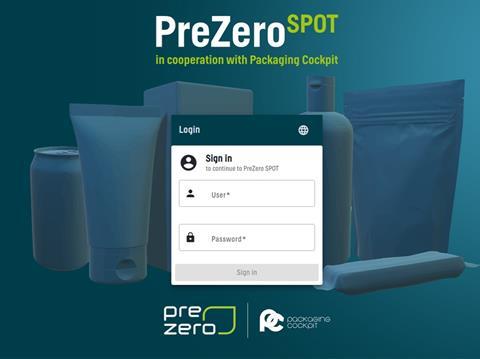
Last year, we reported on the launch of PreZero’s online tool, PreZero Spot, designed to help packaging manufacturers and distributors save resources, cut down on packaging waste, and optimize their sustainable packaging designs by evaluating their own product portfolios. Today the company announced that it has entered into a partnership with the Packaging Cockpit – a tool that calculates the technical recyclability and life cycle assessment of packaging systems.
When assessing the recyclability of packaging, the online Sustainable Packaging Optimization Tool (SPOT) takes into account not only the material and packaging design, but also the disposal structures of all EU countries. The tool lists the respective CO2 footprint and relevant costs such as plastic taxes, license fees and litter funds on a country-specific basis, thus enabling a comparison on a European level.
Under the new partnership, PreZero and Packaging Cockpit experts tell us they can now complement the online tool with additional consulting services upon request. These cover the entire packaging value chain - from product design, production and utilization to the recycling of materials for reuse in new products.
We were interested to know what was behind the upgrades to the existing tool, and what challenges it helps users address, so we spoke to Alexander Reitz, Team Lead at PreZero. Was it, we asked, driven directly by customer feedback on the first iteration of the tool?
“Yes, absolutely. The general feedback on the previous tool was very positive. Customers said it was well designed but they wanted more features. The need we heard most often was comparing recyclability between different countries. Currently, there are so many different standards and country-specific differences. This leads to a lot of confusion and work for companies. Additionally, companies that sell their products in multiple countries don’t want to design different packaging for every country. They want to harmonize and standardize as much as possible. To do this, you need an all-encompassing view of the recyclability landscape. Other often requested features were the inclusion of other sustainability KPIs like carbon footprint, the analysis of EPR fees and plastic taxes as well as better tools to collaborate and exchange data in the value chain.”
Given the above, why was Packaging Cockpit considered the ideal fit to take the tool to the next level?
“We believe that success in the circular economy will come down to the willingness and ability to cooperate. In this spirit, we determined that transitioning to Packaging Cockpit as the foundation for a Sustainable Packaging Optimization Tool, we are able to address our customers’ needs most effectively and cost-efficiently. We offer the core functions of SPOT for free. While some advanced features of SPOT need to be paid for, the majority of features can be used without cost and tried without risk.
“By cooperating with Packaging Cockpit, PreZero SPOT can now provide all the features customers asked for: Country-specific recyclability that takes into account different sorting and recycling infrastructure throughout the EU. It also allows them to analyze all relevant life cycle analysis metrics like carbon emissions based on reputable Eco Invent Data. And it provides information on EPR fees and plastic taxes in all of Europe.”
By providing SPOT free of charge, PreZero says it also enables market participants to compare different packaging options in detail to determine the best course of action. In addition, efficient data management capabilities allow users to manage their own packaging portfolio. This, says the company, facilitates collaboration and communication between different interfaces in the packaging value chain. Intuitive input fields and simplified data imports make packaging portfolio analysis ‘quick and easy’. As a result, packaging manufacturers and distributors ‘quickly know which products they can optimize and how they perform in terms of sustainability’.
Meeting PPWR requirements
Finally, one of the big topics on everyone’s mind at the moment – at least in the packaging industry is the revised PPWR. Will the SPOT upgrade help users meet expectations here? Yes, according to Alexander.
“SPOT is specifically intended to help market actors prepare for the requirements of the PPWR. The powerful analysis features of SPOT enable producers to create a foundation for the needed transformation of the packaging value chain and to evaluate their options for action. Of course, it is then on them to take action. But if necessary, PreZero is able and willing to assist at every step along the way.
“One big step for preparing for the PPWR is moving away from recyclability standards that are based on a single country, to a more holistic view. While we don’t know all the details on how recyclability will be calculated for the PPWR, we surely cannot focus for example on the German Minimum Standard in our tool. Thus we transitioned to the Packaging Cockpit standard based on the WPO guidelines. This way we can give information that is compliant with country specific particularities while at the same time allowing comparison between countries. For the future, the way recyclability is calculated in the tool will be aligned with the PPWR methodology. To do this, Packaging Cockpit and PreZero are both in close contact with norming bodies like CEN, associations and other packaging industry stakeholders.












No comments yet